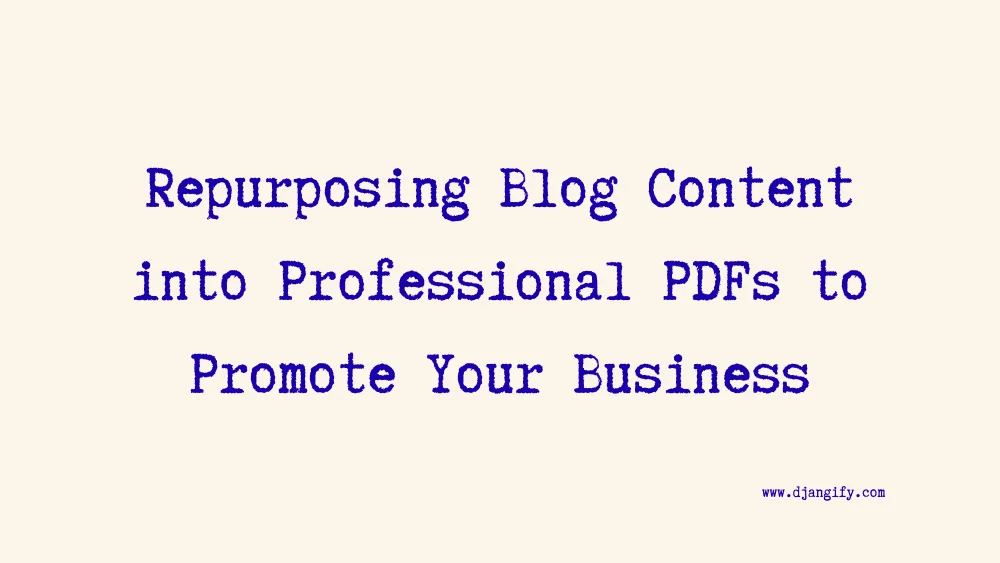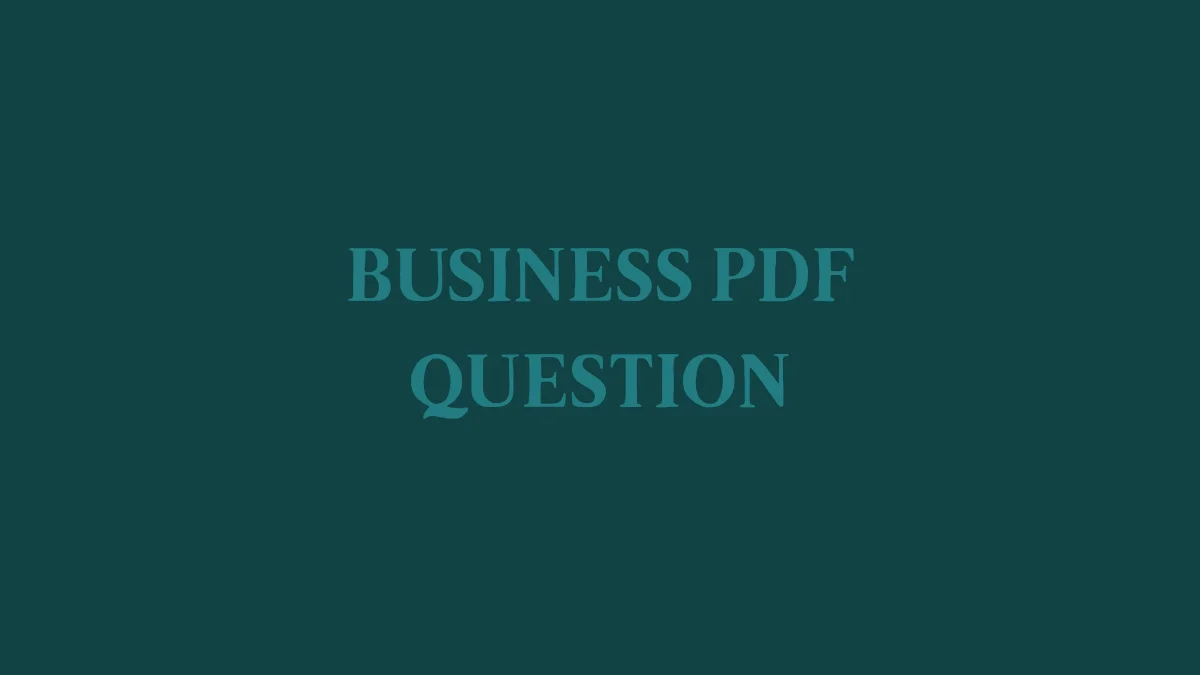Creating quality blog content takes significant time and effort. Yet many content creators publish their posts and then move on to the next piece, missing out on the tremendous opportunity to repurpose that valuable blog content into new formats.
One of the most effective ways to maximise your content investment is by repurposing your blog posts into professional ebooks and comprehensive guides.
This strategy not only extends the lifespan of your content but also helps you reach new audiences, establish authority in your field, and create additional revenue streams. Whether you are a solo blogger, marketing professional, or business owner, learning to repurpose your blog content effectively can dramatically increase your content's impact and return on investment.
Why Repurpose Blog Content?
Blog posts often get buried in archives after their initial publication, despite containing valuable insights and information. By transforming these posts into ebooks and guides, you give your content new life and increased visibility. Professional ebooks can serve as lead magnets, help establish thought leadership, and provide more comprehensive value to your audience than individual blog posts.
Additionally, different people consume content in different ways. While some prefer reading blog posts, others appreciate having a complete guide they can download, save, and reference later. By offering your content in multiple formats, you cater to diverse learning preferences and consumption habits.
Identifying the Right Content for Repurposing
Not every blog post is suitable for transformation into an ebook or guide. The most successful repurposing projects typically involve content that addresses a specific problem, provides step-by-step instructions, or covers a comprehensive topic. Look for blog posts that have performed well in terms of engagement, shares, and comments, as these indicate content that resonates with your audience.
Series of related blog posts work particularly well for this purpose. If you've written multiple posts about social media marketing, project management, or any other focused topic, these can be combined and expanded into a comprehensive guide. Individual evergreen posts that cover broad topics can also be expanded with additional research, examples, and actionable advice.
The Transformation Process
Converting blog posts into professional ebooks and guides requires more than simply copying and pasting existing content. The process involves reorganising information for better flow, expanding on key points, adding new insights, and ensuring the content works as a cohesive whole rather than separate pieces.
Start by identifying the core message or theme that will tie your content together. This becomes the foundation for your ebook or guide. Then, organise your existing blog posts in a logical sequence that builds understanding progressively. Fill in any gaps with new content, research, or examples that strengthen the overall narrative.
Consider your target audience's needs and knowledge level when restructuring the content. What worked for blog readers might need adjustment for someone reading a comprehensive guide. Add introductory material for complex concepts, include more detailed explanations where needed, and ensure smooth transitions between sections.
Design and Formatting Considerations
Professional presentation significantly impacts how your repurposed content is received. While blog posts can get away with simpler formatting, ebooks and guides benefit from thoughtful design choices that enhance readability and perceived value. This includes consistent typography, strategic use of headings and subheadings, and incorporation of visual elements like charts, graphs, and images.
Pay attention to the overall structure and navigation of your ebook. Include a table of contents, chapter breaks, and clear section divisions. Consider adding elements like executive summaries, key takeaways boxes, and actionable tip callouts that make the content more scannable and useful for readers.
The visual design doesn't need to be overly complex, but it should look professional and be easy to read across different devices. Many readers will access your ebook on tablets, e-readers, or mobile devices, so ensure your formatting works well across various screen sizes and platforms.
Adding Value Beyond the Original Posts
Simply repackaging existing blog content isn't enough to create a compelling ebook or guide. You need to add significant value that justifies the new format and encourages people to download or purchase your repurposed content. This might include expanded explanations, additional case studies, updated information, or exclusive insights not available in the original posts.
Consider including interactive elements like worksheets, checklists, templates, or assessment tools that help readers apply the concepts you are discussing. These practical additions transform passive reading into active engagement and increase the perceived and actual value of your content.
You might also add expert interviews, guest contributions, or updated research that wasn't available when you originally published the blog posts. This fresh perspective can make old content feel new and relevant again.
Distribution and Marketing Strategies
Once you have created your professional ebook or guide, you need a strategy for getting it in front of your target audience. This might involve using it as a lead magnet on your website, promoting it through your email newsletter, or sharing it on social media platforms where your audience is most active.
Consider partnering with other content creators, industry influencers, or complementary businesses to expand your reach. Guest posting opportunities, podcast appearances, and collaborative marketing efforts can help introduce your repurposed content to new audiences who might benefit from your insights.
Don't forget about SEO considerations for your ebook landing page. Optimise the page description, use relevant keywords, and create compelling meta descriptions that encourage clicks and downloads.
Measuring Success and Iteration
Track the performance of your repurposed content to understand what resonates with your audience and what might need improvement. Monitor download numbers, engagement metrics, feedback from readers, and any conversion goals you've set for the content.
Use this data to refine your repurposing process for future projects. Pay attention to which topics perform best, what formats generate the most engagement, and how different distribution strategies impact reach and downloads.
Content Repurposing Checklist
Content Selection and Planning
- [ ] Review your blog analytics to identify top-performing posts
- [ ] Look for related posts that can be grouped by theme or topic
- [ ] Identify evergreen content that remains relevant over time
- [ ] Check for content gaps that need additional research or writing
- [ ] Define your target audience for the repurposed content
- [ ] Set clear goals for what you want to achieve with the ebook/guide
Content Development
- [ ] Create a comprehensive outline organizing your selected posts
- [ ] Write connecting content to ensure smooth transitions between sections
- [ ] Expand on key points with additional examples and explanations
- [ ] Add new research, data, or insights not in the original posts
- [ ] Include practical elements like worksheets, templates, or checklists
- [ ] Write an engaging introduction that sets expectations
- [ ] Create a compelling conclusion that summarizes key takeaways
Design and Formatting
- [ ] Choose a professional, readable font and consistent formatting
- [ ] Create a visually appealing cover design
- [ ] Add a detailed table of contents with page numbers
- [ ] Include headers and footers with consistent branding
- [ ] Insert relevant images, charts, or graphics to break up text
- [ ] Ensure proper spacing and margins for easy reading
- [ ] Test formatting across different devices and platforms
Quality Assurance
- [ ] Proofread thoroughly for grammar, spelling, and punctuation errors
- [ ] Check all links to ensure they work properly
- [ ] Verify that all images and graphics display correctly
- [ ] Ensure consistent voice and tone throughout the document
- [ ] Test the document on various devices and reading platforms
- [ ] Get feedback from beta readers or colleagues
Distribution Preparation
- [ ] Create an attractive landing page for your ebook/guide
- [ ] Write compelling marketing copy that highlights the value
- [ ] Set up email capture forms if using as a lead magnet
- [ ] Prepare social media posts to promote the content
- [ ] Create email sequences to nurture leads who download the content
- [ ] Consider creating a shortened version or sample chapters for promotion
Launch and Promotion
- [ ] Announce the launch to your email subscribers
- [ ] Share across all relevant social media platforms
- [ ] Reach out to industry influencers for potential shares or mentions
- [ ] Submit to relevant ebook directories or platforms
- [ ] Consider paid promotion strategies if appropriate
- [ ] Update your website and author bio to mention the new resource
Performance Tracking
- [ ] Set up analytics to track downloads and engagement
- [ ] Monitor email sign-ups if using as a lead magnet
- [ ] Collect feedback from readers through surveys or direct outreach
- [ ] Track any conversions or sales generated from the content
- [ ] Document lessons learned for future repurposing projects
- [ ] Plan follow-up content or sequences based on reader interest
Conclusion
Repurposing blog content into professional ebooks and guides represents one of the most efficient ways to maximise your content creation efforts. By following a systematic approach to selection, development, design, and distribution, you can transform existing blog posts into valuable resources that serve your audience in new ways while establishing your expertise and authority in your field.
The key to successful content repurposing lies in adding genuine value beyond what was available in the original format. This means expanding on ideas, including practical tools and resources, and presenting information in a way that serves your audience's needs and preferences.
Remember that repurposing is an ongoing process. As you create more blog content and gain insights into what resonates with your audience, you'll identify new opportunities to package and present your expertise in formats that provide maximum value for both you and your readers. Start with your best-performing content, follow the systematic approach outlined in this guide, and use the checklist to ensure you don't miss any critical steps in the transformation process.
Frequently Asked Questions
Q: How long does it typically take to convert blog posts into a professional ebook? A: The timeline varies significantly depending on the scope and approach. A DIY project might take 2-4 weeks for a 20-30 page ebook, including content reorganisation, writing additional material, design, and formatting. Professional services can often complete the same project in 1-2 weeks, depending on their workload and your specific requirements.
Q: What tools are best for DIY ebook creation? A: Popular options include Canva for design, Google Docs or Microsoft Word for writing, and tools like Designrr or BookBrush for formatting. For more advanced needs, Adobe InDesign offers professional capabilities but requires a steeper learning curve. Many creators successfully use Canva's ebook templates for professional-looking results.
Q: How do I know if my blog content has enough substance for an ebook? A: Look for topics you have covered across multiple posts that could form chapters, or individual comprehensive posts that could be expanded significantly. Aim for at least 15-20 pages of valuable content. If you can outline 5-7 main sections with substantial information in each, you likely have enough material.
Q: Should I update old blog content before repurposing it? A: Yes, always review and update content before repurposing. Check for outdated information, broken links, changed best practices, and new developments in your field. This ensures your ebook provides current, accurate value to readers and maintains your credibility.
Q: What's the difference between an ebook and a guide in terms of repurposing? A: The terms are often used interchangeably, but guides typically focus more on step-by-step instructions and practical application, whilst ebooks might include broader educational content. Consider your audience's needs: do they want to learn about a topic (ebook) or accomplish a specific task (guide)?
Q: How can I ensure my repurposed content doesn't feel like recycled blog posts? A: Add substantial new content, create smooth transitions between sections, include updated examples and case studies, and reorganise information in a logical flow that builds understanding progressively. Consider adding interactive elements like worksheets or checklists that weren't in the original posts.
Q: Is it worth repurposing content that didn't perform well on my blog? A: Not typically. Focus on your best-performing content that demonstrated audience engagement. However, consider whether poor performance was due to the content itself or factors like timing, promotion, or presentation. Sometimes valuable content simply needs better packaging to find its audience.
Q: How do I price an ebook created from repurposed blog content? A: Pricing depends on your audience, the value provided, and market positioning. Free ebooks work well as lead magnets, whilst paid versions might range from £5-£50 or more for specialised business content. Consider the transformation effort, additional value added, and what similar resources cost in your market.
Q: Can I repurpose the same blog content into multiple formats? A: Absolutely. Blog content can become ebooks, courses, webinars, podcasts, social media series, and more. Each format serves different audience preferences and consumption habits. Just ensure each format adds unique value and doesn't simply duplicate the others.
Q: What legal considerations should I keep in mind when repurposing content? A: If you own the original blog content, you are free to repurpose it. However, ensure any images, quotes, or data you include have proper licensing for commercial use if you're selling the ebook. Always credit sources appropriately and consider trademark implications if using branded terms or methodologies.
Other Articles Worth Reading:
Why Service Businesses should Package Knowledge
Done For You vs DIY
Lead Magnets That Convert


